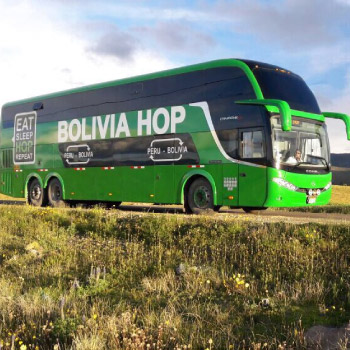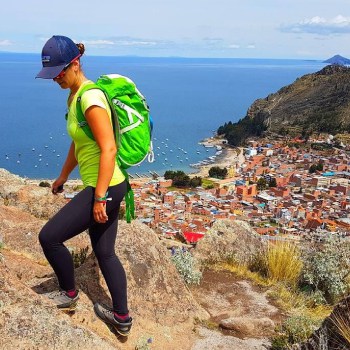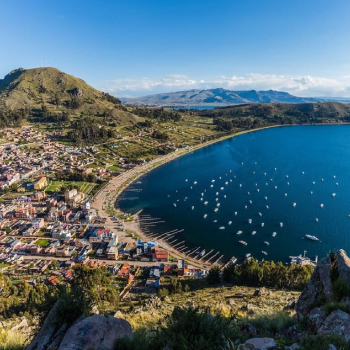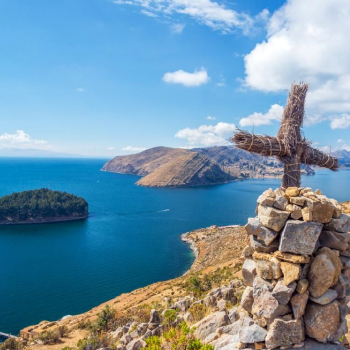Differentiating itself from other parts of the country, Santa Cruz shines due to its tropical savanna climate, low-lying altitude, gorgeous wildlife, vibrant night-life and unique culture.
While unassuming at first, given time, the bustling metropolis unveils itself to be a vivacious city of contrasts. Up-scale restaurants operate alongside local street-vendors, colonial architecture blends with native art, traditional outfits stand out among urban street wear and time-honored customs hold strong against latest trends.
Located at the foothills of the Andes, Santa Cruz is not only the main hub for flights in and out of the country, but the gateway to some of Bolivia’s most adventurous outdoor activities. From wildlife watching and sand boarding to river rafting and hiking, there’s something to suit every travel-taste.
Santa Cruz, while still developing is by far the country’s most contemporary city. Not only is it an ideal starting point for those looking to ease themselves into the Bolivian way of life, but a great place to get off the beaten track – exploring parts of the country often not featured in magazines and guidebooks.
Top Things to See and Do in Santa Cruz
Side Trips From Santa Cruz de la Sierra
Where to Eat & Drink in Santa Cruz
By plane
Located in El Alto, La Paz's international airport is the highest airport in the world at 4,058 m (13,313 ft). The distance between El Alto Airport and the centre of La Paz is around 20 kilometres with an estimated travel time of around 30 minutes. Be aware that during peak hours busses fill up fast, so factor in plenty of time in order to secure a seat.The price of a taxi to and from El Alto airport is Bs 70 ($10 US). Minibuses leave every 5 minutes from Plaza Isabel de Católica and pass by Plaza San Francisco. The cost is around Bs 4 ($0.60 US per person) and busses run daily from 6.15am to 9pm.
By bus
Traveling by bus tends to be the most common way all types of travelers get into La Paz, as they either start further up north or south in South America until they make their way into La Paz. Buses are the cheaper and usually, a more comfortable option, while also getting the chance to enjoy the different sceneries throughout the trip.
For those in Peru coming from Lima or Cusco to La Paz, we strongly recommend Bolivia Hop. They are hop-on, hop-off bus service offering a flexible bus pass (50+ options from long distance to short day trips), in which you can stay however long you want in any of the destinations, letting you enjoy travel at your own pace. Apart from this, there’s onboard bilingual assistance on all their busses, as well as discounts on accommodation. But the biggest advantage of traveling with Bolivia Hop with have to be the border-crossing assistance provided by the onboard guides, who will give you the necessary paperwork and instructions, all while making sure you don't get scammed or lost throughout the process. If you want to learn more about them, click here
For those coming from any of the other bordering countries, there are many options to choose from. But as with most things in life, you get what you pay for. We recommend to fully research the companies, read reviews, blog posts and/or contact the company if necessary!
The following links provide information on how to travel between La Paz and other popular destinations in Bolivia:
Where to Stay in Santa Cruz
By plane
Located in El Alto, La Paz's international airport is the highest airport in the world at 4,058 m (13,313 ft). The distance between El Alto Airport and the centre of La Paz is around 20 kilometres with an estimated travel time of around 30 minutes. Be aware that during peak hours busses fill up fast, so factor in plenty of time in order to secure a seat.The price of a taxi to and from El Alto airport is Bs 70 ($10 US). Minibuses leave every 5 minutes from Plaza Isabel de Católica and pass by Plaza San Francisco. The cost is around Bs 4 ($0.60 US per person) and busses run daily from 6.15am to 9pm.
By bus
Traveling by bus tends to be the most common way all types of travelers get into La Paz, as they either start further up north or south in South America until they make their way into La Paz. Buses are the cheaper and usually, a more comfortable option, while also getting the chance to enjoy the different sceneries throughout the trip.
For those in Peru coming from Lima or Cusco to La Paz, we strongly recommend Bolivia Hop. They are hop-on, hop-off bus service offering a flexible bus pass (50+ options from long distance to short day trips), in which you can stay however long you want in any of the destinations, letting you enjoy travel at your own pace. Apart from this, there’s onboard bilingual assistance on all their busses, as well as discounts on accommodation. But the biggest advantage of traveling with Bolivia Hop with have to be the border-crossing assistance provided by the onboard guides, who will give you the necessary paperwork and instructions, all while making sure you don't get scammed or lost throughout the process. If you want to learn more about them, click here
For those coming from any of the other bordering countries, there are many options to choose from. But as with most things in life, you get what you pay for. We recommend to fully research the companies, read reviews, blog posts and/or contact the company if necessary!
The following links provide information on how to travel between La Paz and other popular destinations in Bolivia:
Shopping in La Paz
By plane
Located in El Alto, La Paz's international airport is the highest airport in the world at 4,058 m (13,313 ft). The distance between El Alto Airport and the centre of La Paz is around 20 kilometres with an estimated travel time of around 30 minutes. Be aware that during peak hours busses fill up fast, so factor in plenty of time in order to secure a seat.The price of a taxi to and from El Alto airport is Bs 70 ($10 US). Minibuses leave every 5 minutes from Plaza Isabel de Católica and pass by Plaza San Francisco. The cost is around Bs 4 ($0.60 US per person) and busses run daily from 6.15am to 9pm.
By bus
Traveling by bus tends to be the most common way all types of travelers get into La Paz, as they either start further up north or south in South America until they make their way into La Paz. Buses are the cheaper and usually, a more comfortable option, while also getting the chance to enjoy the different sceneries throughout the trip.
For those in Peru coming from Lima or Cusco to La Paz, we strongly recommend Bolivia Hop. They are hop-on, hop-off bus service offering a flexible bus pass (50+ options from long distance to short day trips), in which you can stay however long you want in any of the destinations, letting you enjoy travel at your own pace. Apart from this, there’s onboard bilingual assistance on all their busses, as well as discounts on accommodation. But the biggest advantage of traveling with Bolivia Hop with have to be the border-crossing assistance provided by the onboard guides, who will give you the necessary paperwork and instructions, all while making sure you don't get scammed or lost throughout the process. If you want to learn more about them, click here
For those coming from any of the other bordering countries, there are many options to choose from. But as with most things in life, you get what you pay for. We recommend to fully research the companies, read reviews, blog posts and/or contact the company if necessary!
The following links provide information on how to travel between La Paz and other popular destinations in Bolivia:
Events & Festivals in Santa Cruz
Getting To, From & Around Santa Cruz
By plane
Located in El Alto, La Paz's international airport is the highest airport in the world at 4,058 m (13,313 ft). The distance between El Alto Airport and the centre of La Paz is around 20 kilometres with an estimated travel time of around 30 minutes. Be aware that during peak hours busses fill up fast, so factor in plenty of time in order to secure a seat.The price of a taxi to and from El Alto airport is Bs 70 ($10 US). Minibuses leave every 5 minutes from Plaza Isabel de Católica and pass by Plaza San Francisco. The cost is around Bs 4 ($0.60 US per person) and busses run daily from 6.15am to 9pm.
By bus
Traveling by bus tends to be the most common way all types of travelers get into La Paz, as they either start further up north or south in South America until they make their way into La Paz. Buses are the cheaper and usually, a more comfortable option, while also getting the chance to enjoy the different sceneries throughout the trip.
For those in Peru coming from Lima or Cusco to La Paz, we strongly recommend Bolivia Hop. They are hop-on, hop-off bus service offering a flexible bus pass (50+ options from long distance to short day trips), in which you can stay however long you want in any of the destinations, letting you enjoy travel at your own pace. Apart from this, there’s onboard bilingual assistance on all their busses, as well as discounts on accommodation. But the biggest advantage of traveling with Bolivia Hop with have to be the border-crossing assistance provided by the onboard guides, who will give you the necessary paperwork and instructions, all while making sure you don't get scammed or lost throughout the process. If you want to learn more about them, click here
For those coming from any of the other bordering countries, there are many options to choose from. But as with most things in life, you get what you pay for. We recommend to fully research the companies, read reviews, blog posts and/or contact the company if necessary!
The following links provide information on how to travel between La Paz and other popular destinations in Bolivia:
Useful Information
By plane
Located in El Alto, La Paz's international airport is the highest airport in the world at 4,058 m (13,313 ft). The distance between El Alto Airport and the centre of La Paz is around 20 kilometres with an estimated travel time of around 30 minutes. Be aware that during peak hours busses fill up fast, so factor in plenty of time in order to secure a seat.The price of a taxi to and from El Alto airport is Bs 70 ($10 US). Minibuses leave every 5 minutes from Plaza Isabel de Católica and pass by Plaza San Francisco. The cost is around Bs 4 ($0.60 US per person) and busses run daily from 6.15am to 9pm.
By bus
Traveling by bus tends to be the most common way all types of travelers get into La Paz, as they either start further up north or south in South America until they make their way into La Paz. Buses are the cheaper and usually, a more comfortable option, while also getting the chance to enjoy the different sceneries throughout the trip.
For those in Peru coming from Lima or Cusco to La Paz, we strongly recommend Bolivia Hop. They are hop-on, hop-off bus service offering a flexible bus pass (50+ options from long distance to short day trips), in which you can stay however long you want in any of the destinations, letting you enjoy travel at your own pace. Apart from this, there’s onboard bilingual assistance on all their busses, as well as discounts on accommodation. But the biggest advantage of traveling with Bolivia Hop with have to be the border-crossing assistance provided by the onboard guides, who will give you the necessary paperwork and instructions, all while making sure you don't get scammed or lost throughout the process. If you want to learn more about them, click here
For those coming from any of the other bordering countries, there are many options to choose from. But as with most things in life, you get what you pay for. We recommend to fully research the companies, read reviews, blog posts and/or contact the company if necessary!
The following links provide information on how to travel between La Paz and other popular destinations in Bolivia:
Further Reading
By plane
Located in El Alto, La Paz's international airport is the highest airport in the world at 4,058 m (13,313 ft). The distance between El Alto Airport and the centre of La Paz is around 20 kilometres with an estimated travel time of around 30 minutes. Be aware that during peak hours busses fill up fast, so factor in plenty of time in order to secure a seat.The price of a taxi to and from El Alto airport is Bs 70 ($10 US). Minibuses leave every 5 minutes from Plaza Isabel de Católica and pass by Plaza San Francisco. The cost is around Bs 4 ($0.60 US per person) and busses run daily from 6.15am to 9pm.
By bus
Traveling by bus tends to be the most common way all types of travelers get into La Paz, as they either start further up north or south in South America until they make their way into La Paz. Buses are the cheaper and usually, a more comfortable option, while also getting the chance to enjoy the different sceneries throughout the trip.
For those in Peru coming from Lima or Cusco to La Paz, we strongly recommend Bolivia Hop. They are hop-on, hop-off bus service offering a flexible bus pass (50+ options from long distance to short day trips), in which you can stay however long you want in any of the destinations, letting you enjoy travel at your own pace. Apart from this, there’s onboard bilingual assistance on all their busses, as well as discounts on accommodation. But the biggest advantage of traveling with Bolivia Hop with have to be the border-crossing assistance provided by the onboard guides, who will give you the necessary paperwork and instructions, all while making sure you don't get scammed or lost throughout the process. If you want to learn more about them, click here
For those coming from any of the other bordering countries, there are many options to choose from. But as with most things in life, you get what you pay for. We recommend to fully research the companies, read reviews, blog posts and/or contact the company if necessary!
The following links provide information on how to travel between La Paz and other popular destinations in Bolivia:
By plane
Located in El Alto, La Paz's international airport is the highest airport in the world at 4,058 m (13,313 ft). The distance between El Alto Airport and the centre of La Paz is around 20 kilometres with an estimated travel time of around 30 minutes. Be aware that during peak hours busses fill up fast, so factor in plenty of time in order to secure a seat.The price of a taxi to and from El Alto airport is Bs 70 ($10 US). Minibuses leave every 5 minutes from Plaza Isabel de Católica and pass by Plaza San Francisco. The cost is around Bs 4 ($0.60 US per person) and busses run daily from 6.15am to 9pm.
By bus
Traveling by bus tends to be the most common way all types of travelers get into La Paz, as they either start further up north or south in South America until they make their way into La Paz. Buses are the cheaper and usually, a more comfortable option, while also getting the chance to enjoy the different sceneries throughout the trip.
For those in Peru coming from Lima or Cusco to La Paz, we strongly recommend Bolivia Hop. They are hop-on, hop-off bus service offering a flexible bus pass (50+ options from long distance to short day trips), in which you can stay however long you want in any of the destinations, letting you enjoy travel at your own pace. Apart from this, there’s onboard bilingual assistance on all their busses, as well as discounts on accommodation. But the biggest advantage of traveling with Bolivia Hop with have to be the border-crossing assistance provided by the onboard guides, who will give you the necessary paperwork and instructions, all while making sure you don't get scammed or lost throughout the process. If you want to learn more about them, click here
For those coming from any of the other bordering countries, there are many options to choose from. But as with most things in life, you get what you pay for. We recommend to fully research the companies, read reviews, blog posts and/or contact the company if necessary!
The following links provide information on how to travel between La Paz and other popular destinations in Bolivia:
Booking Resources
Photo Credit: Pietro Ferreira









